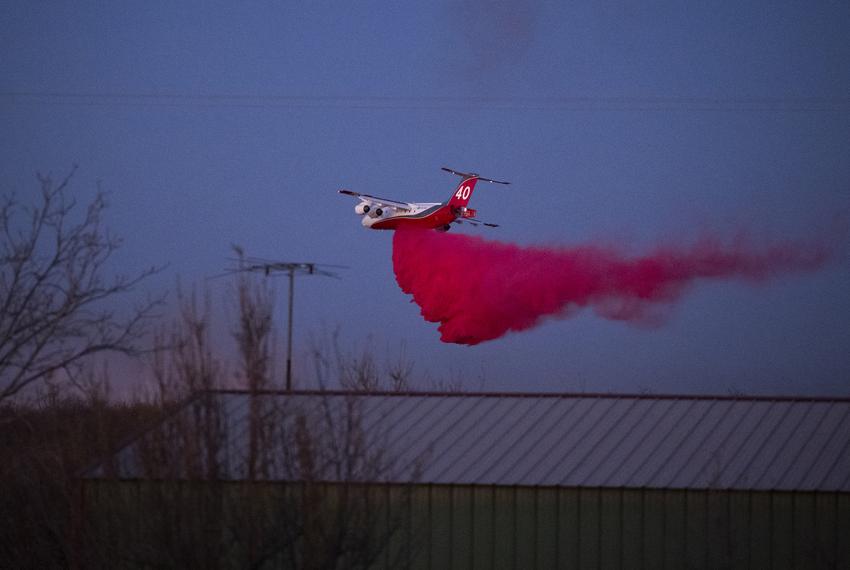/https://static.texastribune.org/media/files/81d8479dfc4db338527bcb765533eeff/0303%20Roughneck%20Fire%20JR%20TT%2003.jpg)
HOUSTON (Texas, US), March 4 (NNN-AGENCIES) — The largest wildfire in Texas history has burned more than 1.1 million acres in nearly a week as dry winds and high temperatures on Sunday fueled the blaze, destroying hundreds of homes and killing at least two people in the state’s Panhandle.
Several wildfires that sparked on Feb 26 across the Texas Panhandle remained active on Sunday, according to the Texas A&M Forest Service. While a cold front is expected to move across the state’s rural Panhandle early Monday, the National Weather Service in Amarillo said critical fire weather conditions will carry through Sunday as temperatures will peak — hitting the 70s to low 80s — in the evening in some areas.
Winds out of the southwest were predicted to gust up to 50 mph with humidity dropping below 15% and grass at very dry levels, according to the weather service. Authorities urged residents to avoid activities that could cause fires and the Texas A&M Forest Service said 65 counties currently have burn bans in place.
The Smokehouse Creek Fire has burned more than 1,078,000 acres, making it the largest wildfire on record in the state’s history. It is one of five wildfires burning in the Texas Panhandle and across state lines into Oklahoma.
As of Sunday morning, the wildfire, which is now five times the size of New York City and larger than the entire state of Rhode Island, is only 15% contained. Weather conditions caused fire activity on the Smokehouse, Windy Deuce and Grapevine Creek fires to pick up on Saturday, Blue Team Operations Section Chief Mike Brod said in a video update on Facebook Sunday morning.
“A RED FLAG warning has been issued and will last through midnight Sunday,” the Texas A&M Forest Service said in a later update Sunday. “Any moisture received three days ago is completely gone. Overnight humidity recovery was poor… Grass fuels are (2%) drier than a day ago and will be very receptive to any heat sources.”
According to a filing with the U.S. Securities Exchange Commission on Feb. 28, investigators from several insurance companies alerted Xcel Energy — a utility company based in Minneapolis, Minnesota — that one of its downed utility poles may have started the fire. Investigators also requested that the “fallen SPS utility pole that is situated within the vicinity of the fire’s potential area of origin be preserved,” the filing stated.
In a visit to the Texas Panhandle on Friday, Gov. Greg Abbott said the cause of the fire remains under investigation and the Texas Department of Emergency Management will continue to assess the damage.
He added that between 400 and 500 structures have burned down, according to early assessments, but investigators are still working to determine the actual toll.
“When you look at the damages that have occurred here, it’s just gone, completely gone. Nothing left but ashes on the ground,” Abbott said. “Those who are affected by this have gone through utter devastation.”
Two women were confirmed killed by the fires this week. But as flames aggressively scorched a wide area, authorities said they hadn’t yet done a thorough search for victims.
Numerous firefighters also suffered injuries, including three who were treated for burns and released from hospitals, said W. Nim Kidd, chief of the Texas Division of Emergency Management.
Two firefighters were injured battling the flames in Oklahoma. One suffered a heat-related injury and the other was injured when the brush pumper he was riding in struck a tanker truck as the two were heading to respond to a fire near Gage. Both firefighters are expected to recover.
In addition to damaging structures and destroying miles of land, the fires have also killed thousands of cattle, officials said this week.
“Over 85% of the state’s cattle population is located on ranches in the panhandle,” said Texas Agriculture Commissioner Sid Miller. “There are millions of cattle out there, with some towns comprising more cattle than people. The losses could be catastrophic for those counties.”
On Friday, ranchers searched for corpses of cattle to dispose and officials said those severely burned or injured would be euthanized. For some ranches, the impact could be severe, though the effect on consumer beef prices is likely to be minimal.
“These cows you see dead are worth between $2,500 and $3,000 apiece,” X-Cross-X Ranch operator Chance Bowers said. “Financially, it’s a massive, massive burden on us.” — NNN-AGENCIES




